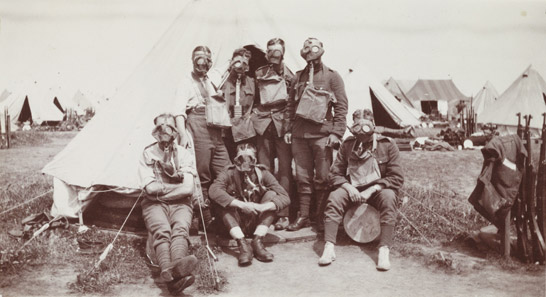
The idea of a compact camera, small enough to slip conveniently into your pocket, may seem like a fairly recent innovation. However, like most things in photography, the idea has been around for a lot longer than you might think.
One of the first and most successful ‘compact’ cameras appeared 100 years ago, in April 1912.
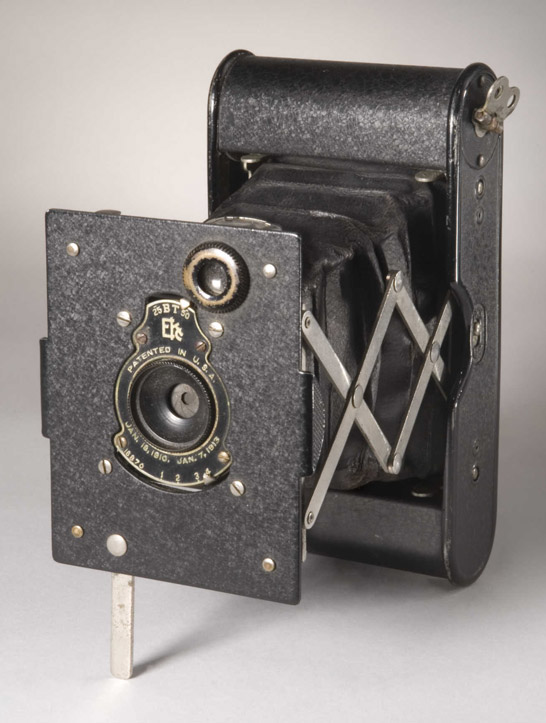
The Vest Pocket Kodak camera, or ‘VPK’ as it was usually known, was one of the most popular and successful cameras of its day. Over 2 million were sold before the model was discontinued in 1926.
During the first decade of the 20th century there was a growing trend toward pocket-sized cameras. In January 1912, The Amateur Photographer magazine commented:
It is a matter for conjecture in what direction the desire for diminutive cameras (so readily met by photographic manufacturers) is leading the amateur. The limit must be surely reached soon or… no doubt highly effective cameras for plates the size of postage stamps (or smaller) will eventuate.
The Vest Pocket Kodak took film negatives slightly larger than a postage stamp—just 1⅝ by 2½ inches. This format was the same as the No 0 Folding Pocket Kodak which had been introduced 10 years earlier. However, improved design and manufacturing the camera body in metal instead of wood meant that the VPK could be made much smaller. When closed, the VPK measures just 1 by 2½ by 4¾ inches.
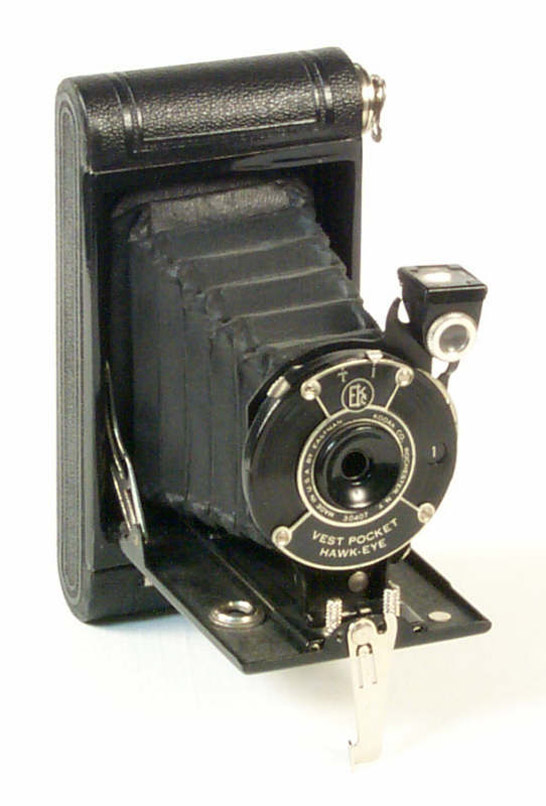
‘Vest’ is the American term for a waistcoat, and the camera lives up to its name. As The Amateur Photographer noted in its review:
The Vest Pocket Kodak does not belie its name, and is small enough to be carried in a waistcoat pocket without inconvenience.
In use, the lens panel pulls out on a pair of lazy-tongs struts. The basic VPK was fitted with a two-speed ball bearing shutter—1/25 and 1/50 sec—and a fixed-focus meniscus lens. Many variants with different lens and shutter combinations were also produced.
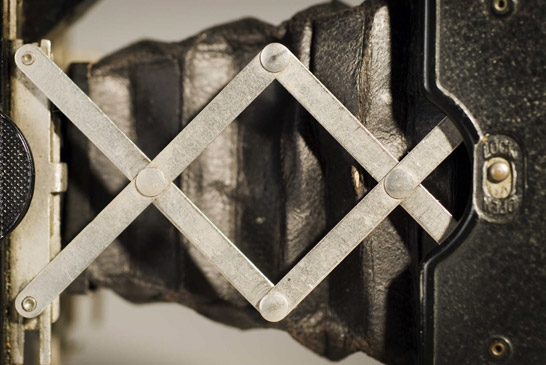
The VPK was favourably reviewed by the photographic press. The British Journal Photographic Almanac, for example, thought that:
In the very excellent design and finish of the apparatus we see the familiar determination of the Kodak makers to produce always the best type of a given article. The Vest Pocket Kodak, though taking a very small picture, is nevertheless a thoroughly reliable instrument, and not at all dear at its price of £1 10s (£1.50).
In 1913, Kodak decided to change the way the many different roll-film sizes it produced were identified.
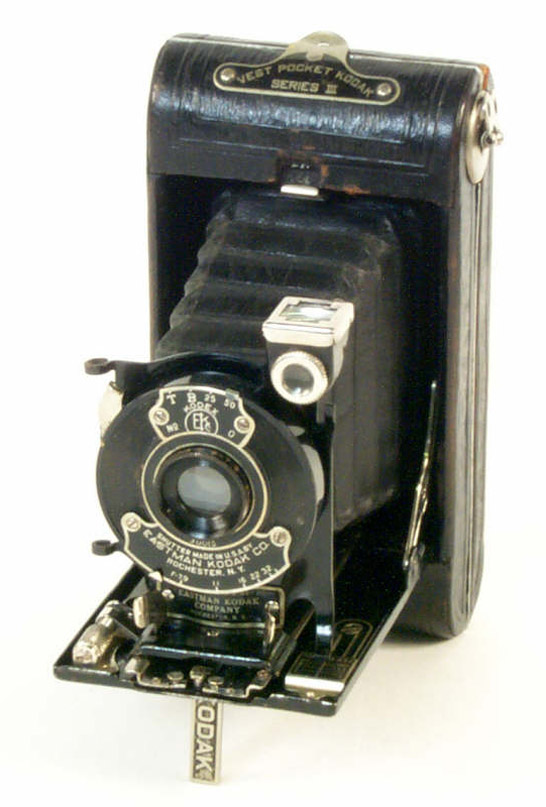
Up to this time, films had been identified by the type of camera they fitted. To simplify things, a consecutive numbering system, starting from 101, was adopted, with numbers allocated in the order in which the various film sizes first appeared. Film for the VPK was the 27th roll film format to be produced and became 127 film. It was a very popular film format for many years; Kodak only stopped producing 127 film in 1995.
In 1915, the ‘Autographic’ Vest Pocket Kodak was introduced.
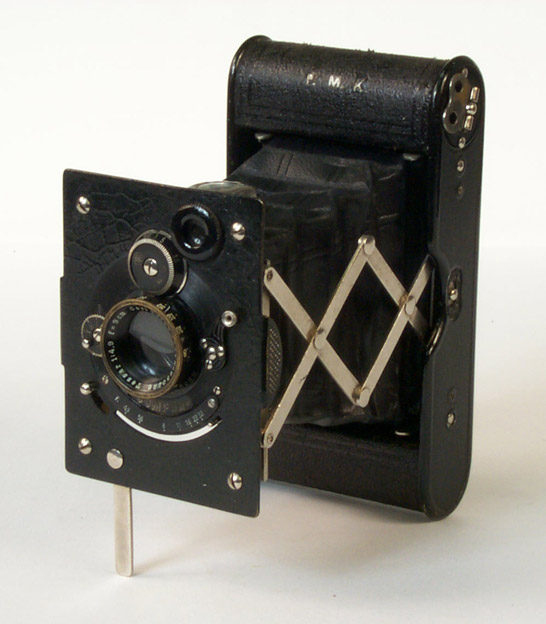
In 1913 an American inventor, Henry Gaisman, had taken out a series of patents for a roll film with a thin carbon-paper-like tissue between the film and the backing paper. A small flap in the camera back could be opened to uncover the backing paper. Pressure from a metal stylus caused the backing paper to become transparent, exposing the film. With autographic film, photographers could ‘write’ information on their negatives that would then appear on their finished prints.
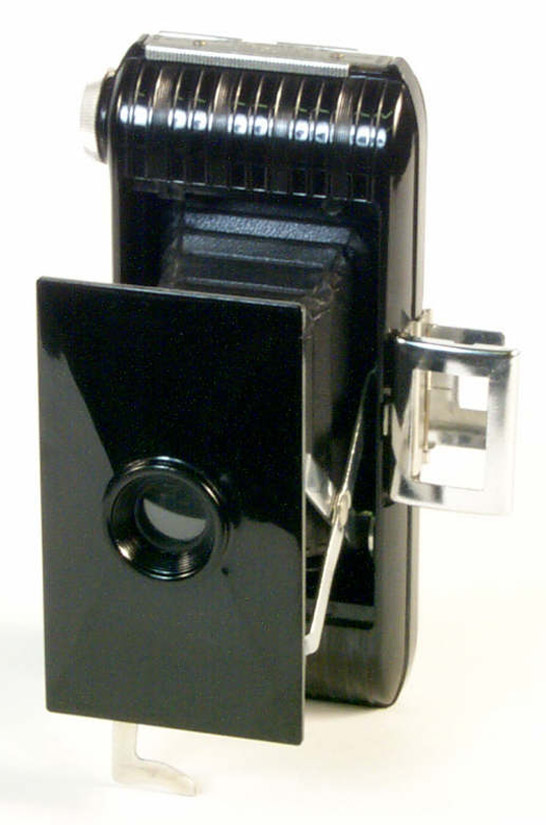
Kodak bought Gaisman’s patent rights for the then-enormous sum of $300,000 and the entire range of folding Kodak cameras, including the Vest Pocket Kodak, were subsequently redesigned to use autographic film.
The introduction of the Autographic VPK coincided with a boom in camera sales linked with the outbreak of the First World War.
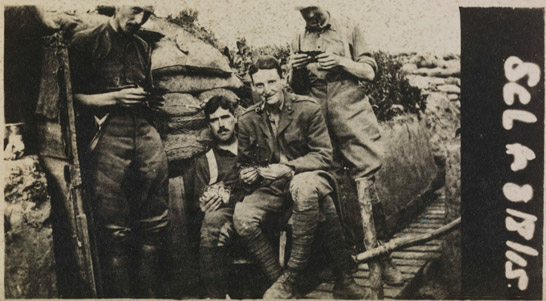
Many soldiers bought cameras to record their travels and experiences. The Vest Pocket Kodak was by far the most popular choice, particularly with American ‘doughboys’. It was widely advertised as ‘The Soldier’s Kodak’ and owners were encouraged to ‘Make your own picture record of the War’.
Sales figures rocketed. In 1914 about 5,500 VPKs were sold in Britain. The following year, this increased to over 28,000.
Colin Harding was filmed in our archives demonstrating the Vest Pocket Kodak for the BBC Four documentary Hidden Histories: WW1’s Forgotten Photographs.
Very interessing article, when I was reading it one question came up in my mind. Can you imagine yourself going in the past like in 1912 with your iphone or samsung s4? The people would consider you as a magician or something similar :-)
Very interesting reading about very.p,k cameras as I like photography my self
Is it possible to obtain recordings of transmission on March 13th. 2014
Hi Ron. This looks like it’s no longer available on iPlayer. You could contact the BBC to find out how you might get hold of a copy.
– Emma
Good post, although it doesn’t explain how the Vest Pocket Kodak could have been “discontinued in 1926” when there is an example shown from 1927. In the United States they came out with the Vest Pocket Model B in 1926– it looks like the Vest Pocket Hawk-Eye is the British name for the same thing, am I right?
I own a Vest Pocket Kodak (Model B) that I’ve shot and developed pictures from, and it really is amazing how small they are. Closed, my VPK is almost exactly the width of my iPhone, maybe 3 cm longer, and maybe 2 cm thicker. I can slip it into the back pocket of my (women’s) tight jeans.
While it’s very simple to shoot with, it’s also quite limited– for an instantaneous exposure you need bright sunlight or maybe very bright light cloud, not within two hours of sunrise or sunset. Otherwise you have to time the exposure– the manual (which I was lucky enough to find a copy of online) has an extensive table of exposure times for everything from taking a picture of someone in a shadow to taking a picture of someone in a low-light room with dark walls (the former is about 1 or 2 seconds; the latter about 40). Nothing closer than I think 6 feet will be in focus. You have to really think about if you can take a snapshot of what you want. Having grown up with totally modern cameras, it’s interesting to experience that kind of thought process– it gives a different, valuable perspective on snapshots of the period.
Where can I find the website for the manual? I can’t figure out what the B and T stand for between the 25 and 50 shutter speeds.
Thanks for the tip. Luckily I live in sunny california so hopefully I’ll get enough use from it!
B. Stands for flash bulb mode. T. Is for time exposer, you can hold the aperture for long exposure under low light conditions.
Flash bulbs didn’t become commercially available until 1930. The ‘B’ setting had nothing to do with ‘flash bulbs’.
B stands for Bulb, when the shutter stays open so long as you press the exposure lever (older wooden cameras had a bulb which you pressed).
T stands for Time, when you press once to open the shutter and then press again to close the shutter after a time interval.
I have one of these, they belonged to my grandad…
I’m looking at selling it. Would you know anyone thst would be interested.
If not anywhere I could maybe get a quote.
Do you have examples online of the photographs you took with the vest pocket? Curious about the film as well.
The Vest Pocket Kodak (or VPK) referred to in this article was of a different construction (using a scissor strut, for example), than the Vest Pocket models that came after, which were a folding-bed type, such as yours. The VPK model was, indeed, discontinued in 1926, though the name “vest pocket” continued to be used by Kodak for other models for several years afterwards.
I have this camera and actually found someone who produces the film they’re called blue fire film
Interesting article, but I have a VPK with the patent date of March 4, 1902. Does this contradict the assertion the camera was introduced in 1912? I’d like to know. If anyone wants photos of my camera, I’d be glad to supply same.
I would like to see photos of your camera and any photos taken with the camera. Do you know if you can find any of the scribe film mention on the article?
Carlos,
I have two KVP cameras. The older one is a bit rough, and the newer one is nearly “as new”, with box (two parts) and instruction booklet.
Here is a dropbox link to the photos of both cameras:
https://www.dropbox.com/sh/eejredoimrcr71o/AACe4toj4ADF3trc5TfACoQia
I do not have any photos taken with either one, nor can I help you with any source for film.
-db
Thanks for the help, No i have not found the scrib film just regular color negative or black and white film that fits. And I did take it out for a test run along hwy 1 the images were blurry because I didn’t extend the bellow all the way. Right now it’s being cleaned lubricated and adjusted and I was having them work on the bellow problem. But I would be happy to send photos etc. whats the best way to do that?
Not at all. Many Kodak cameras incorporated features that were patent before the camera entered production. The 1902 is the patent date for a feature included in the VPK.
That patent is probably for a sub-component of the camera, such as the shutter mechanism, or a method of construction.
I too have this camera with this pat. date. The leather case has a different date though…. any thoughts? You use this?!
Carlos – actually B stands for Bulb, as in the old-fashioned rubber bulb that operated early pneumatic shutters. It means the shutter stays open as long as you hold it down. T (=Time) means you press twice, once to open and again to close. There were no flashbulbs until much later.
Dave – There will be Kodak technology still covered by their 1902 patent, incorporated in the design somewhere. Quoted patent dates can be up to 20 years earlier than the manufacturing date. The camera did indeed appear in April 1912.
I have this camera and would like to sell it. Anyone interested? Terecemugno@yahoo
Brilliant article. I have just inherited one of these cameras, and wasn’t sure how old it was or anything. Ours is the the B model, not the Hawkeye. Which is a bit puzzling as not of my family travelled to America. Perhaps it was purchased somewhere in the UK later?
Hmm is anyone else encountering problems with the images on this blog loading?
I’m trying to determine if its a problem on my end or if it’s the blog.
Any feedback would be greatly appreciated.
Where and how did they have their film developed? Especially if taking pictures was banned, how did they manage?
Marsha, I guess they removed the films and sealed them then got them and the prints processed either in a place away from the front like Amiens or brought them home with them. The book “Tommys War” by Richard Van Emden ISBN 978 1 4088 4436 8 is illustrated throughout with photos taken using this camera
I’ve just bought myself one of these and love the design. It’s great reading through the comments and learning more. As an avid photographer myself, I’ve only just recently started collecting old cameras, the older and the more interesting the better. Can anyone tell me what the metal scribe tucked in the back would be used for? I’m guessing maybe to move the little levers to select shutter time and aperture?
Okay, I’ve discovered what the “scribe” is for now. The “stylus” is for writing on the film once you’re done. Cool.
It was used to write the note on the autographic film. Mechanical pressure on the film would form a latent image.
Soak your nails in olive oil for five minutes.
Hey, thanks a lot about this very thorough documentation.
I found some commentaries in CE Gadda’s war diary about having what he calls a West Pocket camera while in the trenches in Italy during WWI – 1915-16, so I got here to document myself better.
Cheers!
I have a vest camera with 1908 patient printed on the front.also covered in brown leather.cannot find this model .need help please norman.
I have this same camera
I have one of these cameras – handed down through the family. The front plate (where the lens sticks out) has settings info on it (cloudy, sunny etc) and the number 14676. Were these cameras numbered and can they be dated from this number (as leicas can)?
Have in my possession a VP with a number stamped on the ( kickstand) 1558042, can the approximate date of manufacture be ascertained by this # ? Also would the camera have any $ value? Thank you for your time- Carl
having just cleared my late dads shed out i came across a camera in a box, it says on the front VPK model B, would it have any value please?
Of course it has value Sue, but nothing huge. You can pick these up for less than $100USD.
I have been shooting a project with a 1916 VPC (I have two) the results are completely random . even when the camera is set correctly ,shoot 3 pictures of the same thing and the results are completely different .
tricky but good fun.
127 film is now easy to get hold of in colour or B/W .
https://jeffmoore.co.uk/albums/k0BE1/ww1-kodak-1916-vest-pocket-camera
Hi l am going back in time l am during a class on vintage photography my grandfather during ww1 had one of those cameras
i love canteens hahahaha
I have one of this VPK camera with good condition included box and manual book. It’s called Kodak Bantam, produced 1938 with 135mm film format.
how much is a old camer worth that was through the first war war
I just purchased a Kodak Vest Pocket camera with a rare Suter Basel optics
That, sir, I would love to see!
£1.50 could be 6 weeks rent !! not so cheap
Left field inquiry.
I have a WW1 photo album of photos taken by my late uncle, who died at Pozieres in 1916. Captions have been handwritten under the photos by his sister. I am guessing the camera was a KVP, but that may be incorrect. In those dark years, how would the films have been developed? Perhaps they were mailed home with a separate list of locations but the accuracy and detail on the captions makes this seem unlikely. Anyone with any suggestions?
Is it known when the Vest Pocket Kodak was patented in the USA, In the UK, in Germany?
Note that the British Ensignette of 1909 was an even smaller roll film camera. It was also advertised as a vestpocket camera.
Just purchased a VPK 1A Jr. Today. In very good condition. Probably starting a new addiction 😜
I just finished a project using a 1913 patent date Ball Baring VPK lens I received in a parts lot several years ago. It was gummed up and the glass was foggy so it sat in a drawer for years. I recently cleaned it up and got it working. I mounted it into a modified M42 body cap then put it on the end of an M42 billows. The 35mm camera I will be using is an M42 mount camera with a meter (takes the guesswork out of the exposure). I can focus it from infinity down to a gnat’s hair. I will be using 35mm Ilford Orthochromatic film (ISO 80) to mimic the limited light spectrum films of the day. I will put the old lens on “T” mode open and let the camera’s shutter and meter do the work. Now I just need to find a World War I re-enactment to photograph.
Reading a book, the Earl and the Pharaoh, 1916 the Earl Carnarvon elected president of the camera club of England. Kitchener promoted the introduction in a few new additions to the war effort first the tank and the royal flying Corps an obvious role in reconnaissance used the model B. The Earl carnarvon helped the enlisted men to use the model B for reconnaissance. Interesting note the fifth Earl of Carnarvon lived in England Highclere castle, best known as the set for Downton Abbey. later years in Egypt worked and financed, Howard Carters discovery of King Tutankhamun royal tomb in the valley of the kings.
so interesting all of this, i found an almost new model B and i am starting to use it, all of this info was extremely useful. Thank yall!
My grandfather took approximately 300 photographs, mostly with his 1916 VPK, of the Mexican Border campaign and in France with the 102nd US Infantry, 26th “Yankee” Division, until personal photography became strictly verboten in the AEF just before the Second Battle of the Marne in July 1918. I bequeathed his collection to the Connecticut State Library. They’ll be getting his medals and his VPK when I can no longer adequately and safely display them. The benefit of donating his photographs to the CSL is that they professionally digitized them, something I could not do myself to my satisfaction.